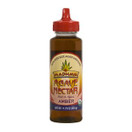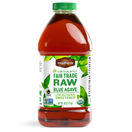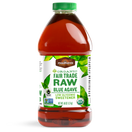Categories
Categories
Brands
Brands






- Home
- Organic Food Products
- Madhava Organic Agave Nectar Amber, 46 oz.
Madhava Organic Agave Nectar Amber, 46 oz.
Product Description
Madhava Organic Agave Nectar Amber, 46 oz.
Madhava Organic Agave Nectar Amber is mild and delicious.
Madhava's Agave Nectar has many fine qualities that make it ideal for all of your sweetening needs. Among them are its certified purity, consistent delicious mild flavor and a lengthy shelf life (won't crystallize). And, importantly, agave nectar has a low glycemic index that is beneficial for many. Plus, it is so easy to use as it pours and dissolves quickly, even in cold food or drinks. But, best of all, it simply tastes great and enhances the flavors of any food it sweetens. Enjoy!
Madhava Amber Agave Nectar is an all-natural sugar replacement made purely from the juice of the Weber Blue Agave plant. It's a simple plant based food that is a healthy alternative to processed sugar and artificial sweeteners.
Our Amber Agave has a subtle maple-like flavor making it a delicious addition to entrees, sauces, roasted meat, and many other dishes. A great substitute for brown sugar, maple syrup or molasses!
- Organic
- Kosher
- Non GMO
- Low Glycemic Sweetener
- Gluten Free
- Vegan
- Fair Trade Certified
- BPA Free
- No Additives or Preservatives
- 1.4 times sweeter than sugar

Certified Organic by: Colorado Dept of Agriculture
Kosher Certified: ![]() Scroll K, VAAD Hakashrus of Denver
Scroll K, VAAD Hakashrus of Denver
Net Wt. 46 oz. (1304g)
Ingredients: 100% Pure Organic Agave Nectar (Amber)
|
Nutrition Facts Serving Size 1 tablespoon (21g) Serving Per Container 62 |
|
|
Amount Per Serving |
% Daily Values |
|
Calories 60 Calories from Fat 0 |
|
|
Total Fat 0g |
0% |
|
Trans Fat 0g |
0% |
|
Sodium 0mg |
0% |
|
Total Carb. 16g |
6% |
|
Sugars 16g |
|
| Dietary Fiber 0g |
|
|
Protein 0g |
0% |
Agave syrupA Complete GuideAgave syrup (also called agave nectar) is a sweetener commercially produced in Mexico, from several species of agave, including Agave tequilana (also called Blue Agave or Tequila Agave), and the Salmiana, Green, Grey, Thorny, and Rainbow varieties.Agave syrup is sweeter than honey, though less viscous. Agave syrup is produced in the Mexican States of Jalisco, Michoacán, Guanajuato and Tamaulipas, according to Mexican laws pertaining to certificate of origin, although most is produced in Jalisco.
ProductionAgave Salmiana:Agave nectar is a pure and natural sweetener made from the natural juice (aguamiel) of the agave salmiana. It is harvested from live plants in the high desert region of Central Mexico, where a wealth of the plants grow wild. It is gathered by hand by Hnahnu Indian peoples native to this area, from plants on their land. Mature agave plants produce a flower stalk. By removing the flower, a bowl shaped cavity is formed- a container into which the aquamiel is secreted. The plant produces this liquid for 6-8 months, during which up to 8 quarts are removed twice daily. A hollowed out gourd is used to siphon the aguamiel from the plant and transfer it to a container. Once the aquamiel is collected, it is immediately taken to the production facility. There, an organic, vegan, grain-free enzyme is added, transforming the naturally occurring sugar molecule chains into more simple sugars, mostly fructose or "fruit sugar" and a small amount of glucose. Excess water is evaporated. Blue Agave:Organic Blue Agave nectars are species-specific, made exclusively from Central Mexico's renowned Blue Agave plant. Blue agave shapes its native landscape, adding color and character to thousands of acres of Jaliscos subtropical region. Blue agave (Agave tequilana var. Weber), a member of the Amaryllis family, is a slow-growing plant that spreads runners from a 'mother' plant. The runners are then harvested and replanted; some are cultivated for blue agave nectar (or tequila), while others become new mother plants. Grown to USDA Organic Standards, the agave is cultivated and processed without chemicals or genetic modification. After growing for 5 to 7 years, a mature blue agave stands several feet tall and its carbohydrates are concentrated in the plant's core. The blue agaves treasure is held in the pina (so called because it resembles a pineapple after the leaves have been trimmed away). Wax in the blue agaves long leaves gives the species its bluish color. Farmers hand-cut the blue agave with a simple razor-sharp blade. (A skilled farmer can cut and trim a 100- pound blue agave pina in less than 5 minutes.) The field trimmings are left behind to restore the soil and reduce erosion. The fibrous blue agave pina is taken to the mill where it is pressed and its inulin-rich juice is collected and cleaned. Inulin, a dietary fiber made up of complex carbohydrates, is not sweet by nature. Cooking (or hydrolyzing) the inulin transforms it into sweet nectar. When making the Light Blue Agave nectar, the juice is heated to 161°F* (72°C). However, when making the Raw Blue Agave nectar, the process is lower and much slower: the juice is warmed to a tepid 118°F (37°C), and the low heat is maintained for nearly twice as long. In this simple process, the inulin becomes fructose, a slowly metabolizing simple sugar found in many fruits and vegetables. Filtering determines the blue agave nectars flavor and color. The Light Blue Agave is simply more filtered than its Raw-Amber counterpart. * It's purely coincidental that Light Blue Agave is hydrolyzed at 161°F, the same temperature that milk is pasteurized. The intent in exposing the agave's liquid inulin to that temperature is to convert it to fructose, not to pasteurize it. CompositionAgave Nectar is very versatile, suitable for any sweetening use. And, it has both organic and kosher certification, is gluten and allergen free, and has a low Glycemic Index of 32. This is significant because limiting glucose consumption is a vital concern for many people. The main carbohydrate is a complex form of fructose called inulin or fructosan. The filtered, hydrolyzed juice is concentrated to a syrup-like liquid a little thinner than honey and ranges in color from light to dark depending on the degree of processing. The syrup naturally contains quantities of Iron, Calcium, Potassium & Magnesium which contribute to the resulting color. There is a United States patent for a process that uses enzymes to hydrolyze the polyfructose extract into fructose, using an enzyme derived from Aspergillus niger (black mold). Culinary use
VarietiesAgave nectars are sold in light, amber, dark, and raw varieties. Light agave nectar has a mild, almost neutral flavor, and is a great choice for use in delicate tasting deserts, baked goods, sauces, and beverages. Amber agave nectar has a medium-intensity caramel flavor, and is suitable for many desserts, as well as sauces and savory dishes. It is an excellent "straight out of the bottle" syrup. Dark agave nectar has stronger caramel notes, and imparts a delicious and distinct flavor to many desserts. It's best used in poultry, meat, and seafood dishes, and is wonderful as a topping for pancakes and waffles. Raw agave nectar also has a mild, neutral taste. It is produced at temperatures below 118°F to protect the natural enzymes, so this variety is a perfect sweetener for raw foodists and the health conscious. What is the difference between the raw, light and dark agaves? The difference is due to the filtration of salts and minerals in the production, which is controlled to produce a consistent product. Raw Organic Agave Nectar is produced at temperatures below 115°F and has a sweet neutral flavor. The lighter grades of Agave Nectar are flavor neutral, enhancing the natural flavors of coffee, tea, fruit beverages, baked goods, fresh fruits, fruit smoothies, salad dressings, jams and jellies, ice cream, yoghurts, and various prepared foods, without altering heir flavor. This is in marked contrast with bee honey, malt barley syrup, and certain other natural sugar substitutes that do alter the flavor of the products which they sweeten. The amber and dark grades offer the delicate flavor of Agave with increasing intensity. The amber grade is much like honey and delicious in tea, suitable to sweeten a wide variety of foods, dry and hot cereals, pancakes, waffles, baked goods, protein drinks, and sauces. Heavier sauces such as BBQ, spaghetti, stews and meat glazes may be enhanced by the darker grades of this sweetener which deliver the rich and complex flavors distinctive to Agave. In addition, a small amount of traditional dark agave is added to the amber to enhance the color and flavor. What is the shelf life of agave nectar? Unopened, Agave will last for more than a year. The color and consistency remains stable and uniform and should be stored well-sealed in a cool dark place. Does agave require refrigeration once opened? No, Agave is best kept at room temperature, and is good for at least 12 months once opened. |
 Loading... Please wait...
Loading... Please wait... 







